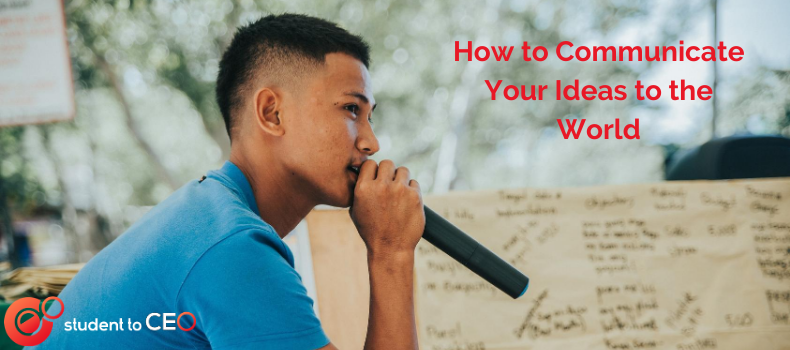On my first day of school, I was as nervous as any 4-year-old would be: “Will I make new friends? Will my mom still get me ice cream if my grades are bad?”
That was until I learned that I need to translate these difficult questions…IN FRENCH! I didn’t even know how to spell it, let alone speak it. I pleaded. I yelled, but NO. My parents did as any immigrant parents would: investing in a better future for me by obligating me to learn the French language and its culture. Years later, French is one of the best gifts I’ve been given.
Communication and the ability to do so effectively is critical for everyone. There’s no point in having a great idea if you can’t share it with anybody.
When I began my university studies, I seized the opportunity to refine the communication skills through John Molson’s Case Competition program and outside of school, helping start-ups raise capital.
Throughout my journey, I came across students who reminded me of my old self, non-native speakers being asked to perform quadratic equations in French while balancing a diet of ice cream with a newfound love of poutine. Okay, maybe not all of that. But, I met individuals with great ideas that were too encumbered to present and to communicate with others. I felt their anguish, and I wanted to help them reach their full potential.
I launched MasterTalk, a YouTube channel dedicated to providing those aspiring individuals every tool they need to know to communicate effectively. I believe that anybody who learns to master their talk will become a better version of themselves in all aspects of life.
In this article, I will share my 6 public speaking lessons that can help you master your talk.
Master Silences
Exceptional public speakers use moments of silence to enhance their presentations, rather than seeing them as a sign of weakness. When you pause in a presentation, you’re worried that the audience thinks you don’t know your subject, and you start to panic. Whereas, great speakers in the world (think TED talk speaker level) use silence as a tool to give audience members time to think about their key presentation points and draw them in.
Master “Ums” and “Ahs”
How do you get rid of them? Exceptional speakers replace their “ums” and “ahs” with SILENCES! When you practice this, you’ll have trouble completing full sentences without breaking in between them, but trust me, it is crucial that you keep at it.
Master Your Audience
The quality of your presentation is directly related to the number of people in the audience that remember and share your ideas. Therefore, the starting point of any presentation is crafting it in a way that your audience will love. Think about the following: what is the goal of your presentation? Who is your audience and what are their needs / expectations from your presentation? How do you address those needs and expectations in a way that will get them excited to share your message with the world?
Master Your Eye Contact
Eye contact is difficult because it varies according to the audience size, the layout of the room, and whether the presentation has a specific purpose for key individuals or not. I have 3 key rules that apply to any situation:
- NEVER deviate eye contact from your audience or your presentation. Looking away makes you look unsure of yourself.
- ADDRESS every group in your audience. If it’s a small room, make sure you’ve made eye contact at least once with each of them, and if it’s a big audience, make sure you’ve moved your body in their direction at least once.
- PRIORITIZE key decision makers in your audience. Target key audience members that play a significant role in achieving your presentation’s goal and focus your attention on them, i.e. selling strategy services to the CEO of a company.
Master Your Posture
Students make 2 key mistakes in their posture: their legs are too far apart when they present and/or their legs move because they are nervous. By gluing your feet together, this will ensure that your legs don’t move and that they aren’t too far apart. After a few presentations, your feet will naturally separate to an appropriate distance.
Master Mirroring
Imagine waking up in the morning and getting ready for the day. You’re excited: meetings with clients, lunch with your colleagues, and quality time with your loved ones. When you look at yourself in that mirror, you see someone that’s thrilled to be alive and ready to tackle the day. That energy will then be projected to everyone else around you, whether it’s your friends, family, colleagues, or your audience.
But the opposite is also true.
This day stinks. I have to meet clients today, have lunch with colleagues I don’t like, and spend quality time with loved ones I don’t really love. When you look in that SAME mirror, you see someone who’s not excited to tackle the day and that energy is also projected to everyone else around you.
So, what’s the punchline?
The punchline is that as speakers, we ARE MIRRORS. We reflect OUR emotions onto our audience, so if we’re feeling uninterested and bored, our audience will feel that energy as well and if we care a great deal and we want to add value, that energy will also show so choose your emotions wisely.
Mastering public speaking isn’t child’s play. It’s like trying to learn a new language in a foreign school. It will be intimidating; you will want to cry at times. But, if you keep at it and improve, you will WOW yourself and, more importantly, your audience.
Take the leap and master your talk to become your best self! Watch this video to learn three daily public speaking exercises.


Leave a Reply